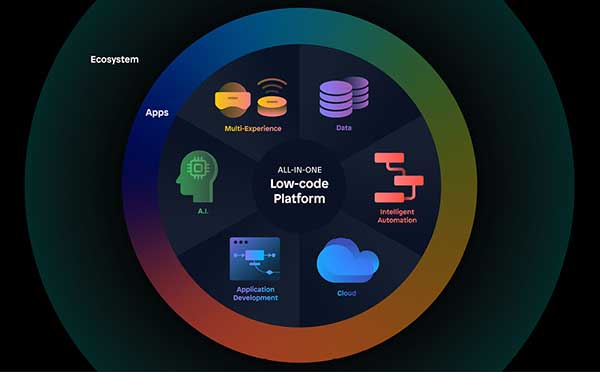Free Suggestions For Picking Low-Code Platform Recommendations
Wiki Article
In Terms Of Speed Low-Code Software Offers A Variety Of Advantages.
The development of applications using low-code significantly improves development speed due to several important factors. Development Environment:
Drag-and-Drop Interfaces: Low-code platforms provide visual tools for designing applications. Drag-and-drop components let developers quickly create applications without the need to write extensive code.
A lot of low-code platforms come with built-in templates or components that enable developers to quickly prototype applications and build them without having to start with a blank slate.
Reduced Coding Requirements for Coding:
Automated Coding Generation: Low-code platforms generate code automatically based on the visual model created by the developers. This helps reduce manual code, and speeds the development process.
Reusable Parts Developers will have the ability to reuse parts that are reusable across different projects, and cut down on the amount of time needed to write and testing code.
Collaboration can be made easier.
Integrated Development Tools: Low-code platforms typically contain tools for managing versions, testing, and deployment which facilitates seamless collaboration between development teams.
Citizen Development: Users of businesses and non-developers are able to contribute to the development of applications using simple interfaces, reducing the bottleneck that is often caused by the limited accessibility of professionals.
Rapid Iteration, Prototyping
Rapid Prototyping Developers are able to quickly build prototypes for ideas to be tested and feedback collected and analyzed, which leads to faster iterations.
Easy Modifications: The visually-oriented nature of low-code development makes it easier to make updates and changes to applications, which accelerates the process of improving and refining applications based on feedback from users.
Pre-built Integrations:
API Integrations: Platforms that are low-code often have pre-built connectors for APIs and services that are popular making it easier to integrate with external systems.
Data integration tools: Tools for data integration are integrated to make it easier for the process.
Scaling and Deployment:
One-Click deployment: Many platforms that make use of low-code have the option of deploying with one click applications, reducing the time and effort.
Cloud-based Platforms: Cloud-based platforms which have low-code capabilities can manage the infrastructure and scale, which means developers can concentrate on the application logic and function instead of the logistics of deployment.
In general, low-code development has advantages in terms of speed due to its capacity of automatizing and simplifying a variety of elements of development. This allows for faster development of apps as well as easier adaptation to changing needs. Have a look at the top Low-code Platform for application development advice for blog recommendations including paas service, rapid application design, low code platforms, build a docker container, develop web app, application modernization software, azure sql, develop web app, rad application development, multiplatform mobile app development and more.

Low-Code Apps Have Numerous Benefits, Particularly In The Area Of Cost-Effectiveness.
Low-code development can bring many benefits in terms of cost efficiency. This is a great option for companies who want to reduce their development budgets while still providing top quality software. Here are the key benefits: Reduced development costs:
Reduced Coding: Low-code systems reduce the amount of manual coding needed, which in turn helps developers save time and energy when building applications. This means lower costs for labor.
Reduced Developer Resources: Since low-code is more efficient and less time to develop, fewer specialized developers will be needed. This could drastically cut costs for hiring and staffing.
Quicker time to market:
Accelerated cycle of development: Visual tools for development as well as pre-built components offered by platforms with low-code enable rapid application development, allowing companies to deliver products to market faster. This can lead to increased revenue as well as improved positioning in the market.
Rapid Prototyping. By rapidly creating and testing prototypes, businesses can cut down on time spent development and iterate faster based upon user feedback.
Reduce Maintenance Costs
Simple Maintenance: Applications developed using low-code platforms are generally easier to maintain due to their standardized components and modular architecture. Maintenance and support costs are reduced.
Automated Updates. A lot of low-code platforms handle updates and patch automatically. Applications remain safe without the need for extensive manual input.
Efficient Resource Utilization:
Platform contributions that are low-code let both business users and others who are not developers to take part in the creation process. This democratization of the development process permits businesses to utilize the skills and talents of a wider number of employees.
Optimized Use of IT Resources: IT departments are able to focus on more strategic initiatives instead of getting bogged down by routine tasks of development increasing overall efficiency and productivity.
Modular Pricing Models that Scale:
Subscription-based Prices: Many lowcode platforms offer flexible, subscription-based pricing models that grow as users use them. This allows businesses the ability to adapt their spending according to their growth and needs, without the need for large upfront costs.
Pay-as-you-go Options Certain platforms offer pay-as you-go options, which ensures that companies only pay for the resources they use and can be especially beneficial for startups and small companies with a limited budget.
Reduced Third-Party Costs for Software:
Built-in Functionalities : Low-code platforms usually comes with built-in functionality and integrations which reduces the requirement for third-party tools, software and licenses.
Integrations pre-built: These systems and services can be integrated with other well-known services, reducing the requirement for custom-designed software and saves both time and cost.
Increased ROI
Faster Return on Invest Accelerating development and less expense and a shorter speed to market, companies can achieve an increased return on investment (ROI).
Improved Agility: Businesses can rapidly adapt to market trends and the needs of customers to ensure they remain relevant and can capitalize on emerging opportunities when they occur.
Lower Cost of Training
User-Friendly Interfaces: Low code platforms offer intuitive and easy-to-use interfaces that reduce the time required to learn.
Accessible Resources: Many platforms that use low-code offer comprehensive training materials, tutorials and support for community members. This eliminates the need for formal education and expenses associated with it.
Collaboration can be made more efficient.
Enhanced Collaboration Tools: Built-in collaboration tools facilitate better communication and coordination among team members, resulting in better development processes and less project overhead.
Unified Development Environment. A single unifying software development environment can streamline processes and decrease the cost and complexity of managing multiple software and platforms.
Overall, the cost-effectiveness of low-code development comes from its ability to cut development and maintenance costs, accelerate the time to market, improve the utilization of resources, and offer flexible pricing models. All of these factors provide substantial financial benefits to businesses which makes low-code an attractive choice for businesses looking to maximize their development budgets while achieving robust, scalable high-quality and robust applications. Take a look at the recommended Enterprise application development with Low-code Platform tips for more advice including cross platform mobile development, rad application development, build with docker, app modernisation, paas service, develop mobile application, azure sql server, mobile development platforms, build a docker container, low code platforms and more.

In Terms Of Vendor Support And Community Involvement, Low-Code Development Can Bring Many Advantages.
Low-code development platforms have distinct advantages when it comes to vendor support and the community. These are crucial to ensure successful implementations, continuous maintenance, and continuous development. Here are some key advantages.
Comprehensive Technical Support:
Support Team with Dedicated Staff: Many low code platforms have dedicated support staff who are available to help with technical questions or troubleshooting issues, as well as providing guidance. They will ensure that issues are addressed promptly.
Certain vendors offer support 24 hours a day. This is advantageous for companies operating across time zones.
Training and Onboarding
Structured Training: Many companies offer structured training, such as tutorials, webinars and certification courses to help users quickly become more comfortable with the platform.
Customized Onboarding A lot of vendors offer personalized services to help their new clients implement the platform efficiently and adapt it to their needs.
Regular Updates and Enhancements
Continuous Improvement: Low-code platform vendors generally release updates regularly which include new features, performance enhancements and security patches ensuring that the platform remains up-to-date and secure.
Feedback Integration: Vendors incorporate feedback from users into their cycle of development to ensure that the platform is constantly evolving to meet the evolving needs of its users.
Comprehensive Documentation:
Documentation in Detail Users will find solutions to their problems by consulting an organized and detailed guide that covers every aspect of the program, from its basic functionality to more advanced customisation.
API References API documentation can help developers customize and integrate applications using the Low-Code platform.
Professional and Consulting Services
Expert Consultation: A number of vendors offer consulting services that assist users in complex design and implementation, as well as strategic planning.
Custom Development Services - Some companies offer custom development services for specific features or integrations not available out of the standard package.
Community Support
Active User Communities
Forums and Discussion boards A number of low-code platforms have lively online communities that allow users to discuss ideas, discuss questions and collaborate.
User Groups and Meetups Virtual and local user groups and meetups are great to meet, network and sharing experiences with fellow users.
Knowledge Sharing and Collaboration:
Community-Contributed Resources: Users often share templates, modules, and extensions that they have developed, which can be reused or adapted by others, accelerating development and innovation.
Crowdsourced Problem-Solving: The collective expertise and collective knowledge of a community can be a valuable source to solve problems and come up with creative solutions to complex problems.
Development and learning:
Community-led Training: Many groups host workshops, sessions for training, and webinars. They are typically conducted by experts in the field, who share practical knowledge and advanced techniques.
Online Tutorials and Courses The community members develop and provide tutorials, online classes and guides on how to use. This improves the learning tools that are accessible to all users.
Feedback and Influence
Product Feedback Channels. Forums for community members usually have channels where you can provide feedback to the manufacturer. This feedback may influence the development and enhancement of features.
Beta Testing Programs. Active community members can participate in beta-testing programs. They will be given early access to the latest features of the platform and an opportunity to shape its evolution.
Recognition and Support
Community Recognition Programs: Many vendors provide recognition programs for active community members. Examples include MVP (Most Valuable Professionals), which recognizes the contribution of community members.
Peer Support Community members frequently offer support to peers by sharing their expertise and offering advice for users who are not as knowledgeable. This fosters a collaborative and supportive atmosphere.
In general, the combination of robust vendor support, and an active and engaged community offers a wide range of support for development with low-code. Users will be able get the help, resources and collaboration opportunities they require to successfully build applications, deploy, keep them up to date and further enhance their apps.
